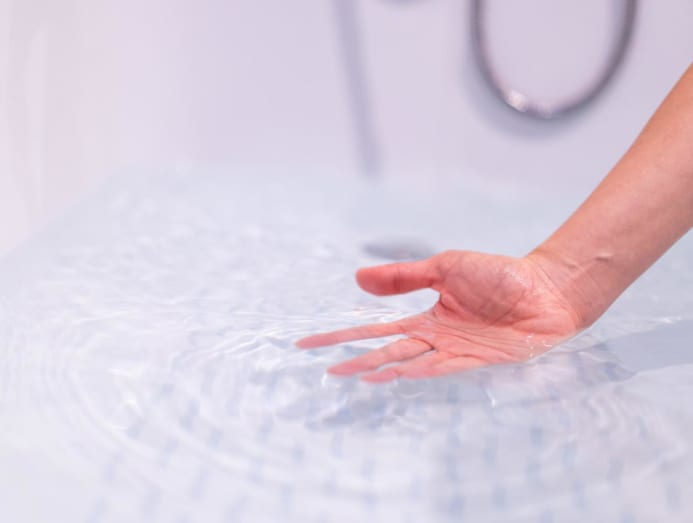4 common injuries mothers may face while giving birth: How to spot the signs and how they're treated
Birth injuries can range from common ones like perineal tears to more severe tailbone injuries but there are things mums-to-be can do to reduce the risk.

Bruising and tears in the pelvic region are a few of the common birth injuries experienced by mothers. (Photo: iStock/globalmoments)
Bringing a child into the world may be life-changing for many women, but labour and giving birth come with some risk.
Dr Christopher Chong, a urogynaecologist and obstetrician and gynaecologist at Gleneagles Hospital, said the majority of injuries, such as bruising around the pelvic region and perineal tears, are common and minor. In rare cases, a woman may suffer more severe injuries, like bone damage, while giving birth.
There are many types of birth injuries, said Associate Professor Tan Lay Kok, who heads the Department of Maternal Fetal Medicine at KK Women’s and Children’s Hospital (KKH). “They are diverse and can range from the position and size of the baby, prolonged or very quick labours, or an abnormal pelvis.”
1. PERINEAL TEARS
What they are: This is a cut or tear to the woman’s perineum – the area between her vagina and anus – that happens during labour. Such tears are common, said Dr Chong, especially for first-time mums as they’ve never given birth before.
He explained that the newborn’s head may be too big for the vagina to stretch to accommodate it as it comes through the vaginal opening, or that while the baby’s head may be of average size, the vagina may not stretch easily.
“The bigger the head of the baby, the more or bigger tears there will be,” Dr Chong said.
The severity of the tears depends on the baby’s position during delivery, he added. They are less severe if the baby’s head is facing downwards while exiting, compared to if it were facing upwards.
Preventing perineal tears: When the baby is close to being delivered, the doctor will make a small cut between the anus and vagina, called an episiotomy, to enlarge the opening and facilitate the birth. The incision helps to prevent bigger and “jagged” tears that may lead to infections.
Mums can also prepare the perineum during pregnancy, such as doing perineum stretches, exercises and massages with their partner’s help, to make the area less firm and tough, allowing for better stretching and fewer severe tears during childbirth, Dr Chong said.

Treating perineal tears: Minor tears heal within a week while bigger tears may take around two to three weeks, said Dr Chong.
To ease the soreness postpartum, new mums can soak in a sitz bath, which is a warm soothing soak for the perineal area to encourage pain relief and healing.
2. DAMAGE TO THE PELVIC FLOOR MUSCLES
What they are: Pelvic floor muscles prevent urine from leaking out when the bladder is full, and during pregnancy, they are “stretched by hormonal changes as well as the increasing weight of the womb”, said KKH’s Assoc Prof Tan.
During labour, these same muscles are also stretched and strained significantly, said Dr Chong, which may cause damage and lead to pelvic organ prolapse or urinary incontinence.
In pelvic organ prolapse, the pelvic organs – the womb, bowel, bladder or top of the vagina – drop lower in the pelvis, creating a bulge in the vagina, which leads to pain and discomfort in the area.
Urinary incontinence refers to a loss of bladder control – the mum could leak urine when coughing, laughing or sneezing.
Preventing damage to the pelvic floor muscles: One way to prevent excessive strain on the pelvic floor muscles during delivery is to maintain a balanced diet and manage your weight during pregnancy as overeating may cause the baby to grow larger than normal, said Associate Professor Tan Thiam Chye, obstetrician and gynaecologist at Mount Elizabeth Novena Hospital.
He also suggested that pregnant mums do regular kegel exercises to strengthen their pelvic floor muscles.

Mount Elizabeth Novena Hospital’s Assoc Prof Tan said getting an earlier assessment of the mother’s body and preparation for the birth can also prevent injury to her pelvic floor muscles.
He discouraged waiting until the last minute to discuss the birth plan with your doctor. Aim to do this within the 34th to 37th week of pregnancy to ensure the safest mode of delivery for both mother and baby.
Treating damage to the pelvic floor muscles: Said KKH’s Assoc Prof Tan: “To facilitate recovery, a specialised women’s health physiotherapist, such as those at KKH, should be able to help the woman rebuild her pelvic floor health.”
Don’t dismiss the traditional practice of confinement, said Dr Chong. It’s a period that allows the mother to rest and for her pelvic floor muscles to recuperate after giving birth.
Do remember, however, that the pelvic floor muscles never fully return to their pre-pregnancy state after childbirth – mums should continue doing regular pelvic floor exercises to maintain strength and function following delivery, he added.
3. DAMAGE TO THE PELVIC BONES
What it is: The pelvis or pelvic region is a circle of bones at the base of the spine. It holds the muscles and protects the organs in your lower belly area. The bony structure around this area is also the narrow passage that a baby takes during vaginal delivery.
If the baby has a large head, it may put pressure on the mother’s pelvic bones during delivery, causing the area to swell and become very intensely sore, said Dr Chong.
The pressure may also create a gap between two bones at the front of the pelvis. Following the delivery, mums may experience pain while walking or exercising the hip area.
In situations where the head is too large to even exit the opening, the doctor may need to crack or manipulate the pelvic bones to ensure safe delivery. However, Dr Chong noted that such cases are rare.

Preventing damage to the pelvic bones: Managing the weight and size of the foetus through a healthier lifestyle and diet would help, said Dr Chong, adding that controlling the size of the baby's head, to the extent possible, can also prevent damage to the pelvic bones.
The method of delivery plays a part too, he said. Should the baby be too large for a vaginal birth, mums may opt for a Caesarean section.
Treating the injury: Minor injuries, such as bruising, which causes a dull ache in the pelvic region, usually heal on their own with adequate rest during the confinement period. It may take six to eight weeks for the mother to recover, Dr Chong said.
However, Dr Chong noted that in cases of severe injury where mums experience fractures or broken bones, an orthopaedic surgeon or a bone specialist may be consulted, and surgery may be needed to realign the bones.
Fractures usually take around six months to heal, during which women may experience slight pain in the groin, hip or lower back, which can worsen while walking.
To recover well, Dr Chong discouraged mums from engaging in strenuous activities like running or jumping as it may delay the healing process or aggravate the existing injury.
4. TAILBONE INJURIES
What they are: The tailbone, also known as the coccyx, is a small bone that helps to support the weight of the upper body when you’re sitting down and serves as a point of balance when you stand upright. In women, it is at the base of the birth canal.
As a woman goes through labour, pressure from the baby's head can bruise, fracture or, in rare cases, dislocate the mother’s tailbone, Dr Chong explained.
In mild cases, the bruising can cause a dull, aching pain at the bottom of the spine. In more severe cases, the woman may experience constant lower back pain that worsens when sitting down and when standing up from a sitting position.

Preventing tailbone injuries: Pregnancy yoga and stretches can help to strengthen the area around the tailbone, said Dr Chong.
The way a woman sits when she’s pregnant matters too. Instead of resting your weight directly on your tailbone, which can be uncomfortable and make you prone to injury, Dr Chong recommends using a cushion or soft surface to provide extra support and protection for the area.
Treating tailbone injuries: Surgery is typically not required, Dr Chong said, especially if it’s just bruising, which should take six to eight weeks to heal. During that time, you should rest and avoid intense physical activity in the lower body. Sitting on soft surfaces helps too.
Healing, in the case of a fracture, may require surgery, and recovery after that could range from three to six months. Dr Chong recommends that mums spend less time sitting down and do light exercises like backstroke swimming, which can help relieve pressure on the tailbone caused by sitting or lying down.
When you next get pregnant, make your gynaecologist aware of your previous tailbone injury, so he or she can advise you on the safest delivery option for you.
WHERE TO GET HELP

The hospitals provide support and helplines for mums should they need to consult a doctor about postpartum pain.
At Gleneagles Hospital’s ParentCraft Centre, a team of trained personnel can provide mums with advice on antenatal, confinement and postnatal care.
Mount Elizabeth Novena Hospital has a variety of services to support women with birth injuries. These include physiotherapy and occupational therapy to help with pelvic floor injuries to counselling for traumatic delivery.
At KKH, women may visit its 24-hour Urgent O&G Centre should they need help after delivery.
It’s also helpful to keep your six-week postpartum checkup with your gynaecologist – here’s where you can mention any areas of discomfort you may have or if you suspect you are not healing as well as you should. It provides an opportunity for any childbirth injuries to be detected, said Dr Chong.
CNA Women is a section on CNA Lifestyle that seeks to inform, empower and inspire the modern woman. If you have women-related news, issues and ideas to share with us, email CNAWomen [at] mediacorp.com.sg (CNAWomen[at]mediacorp[dot]com[dot]sg).








